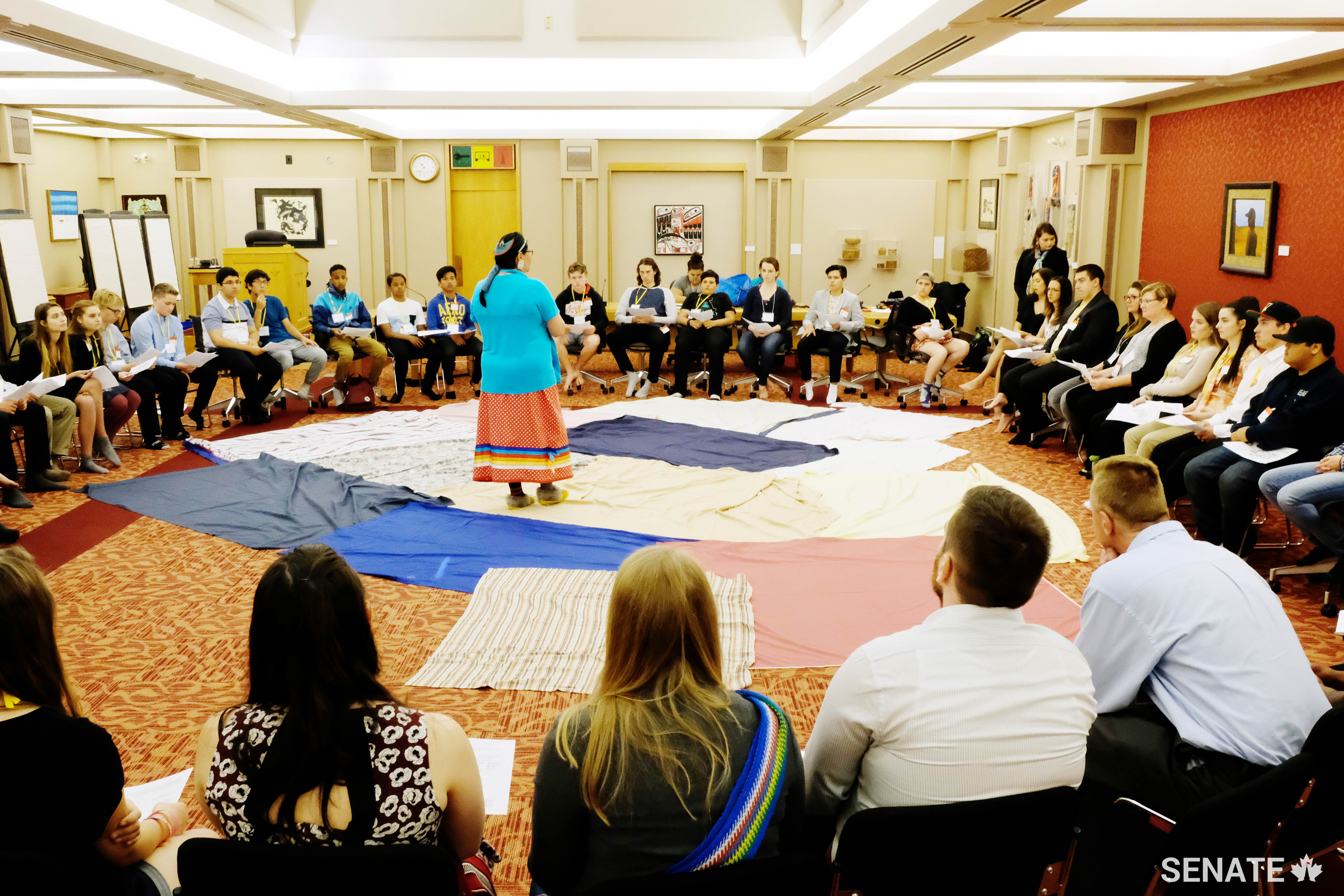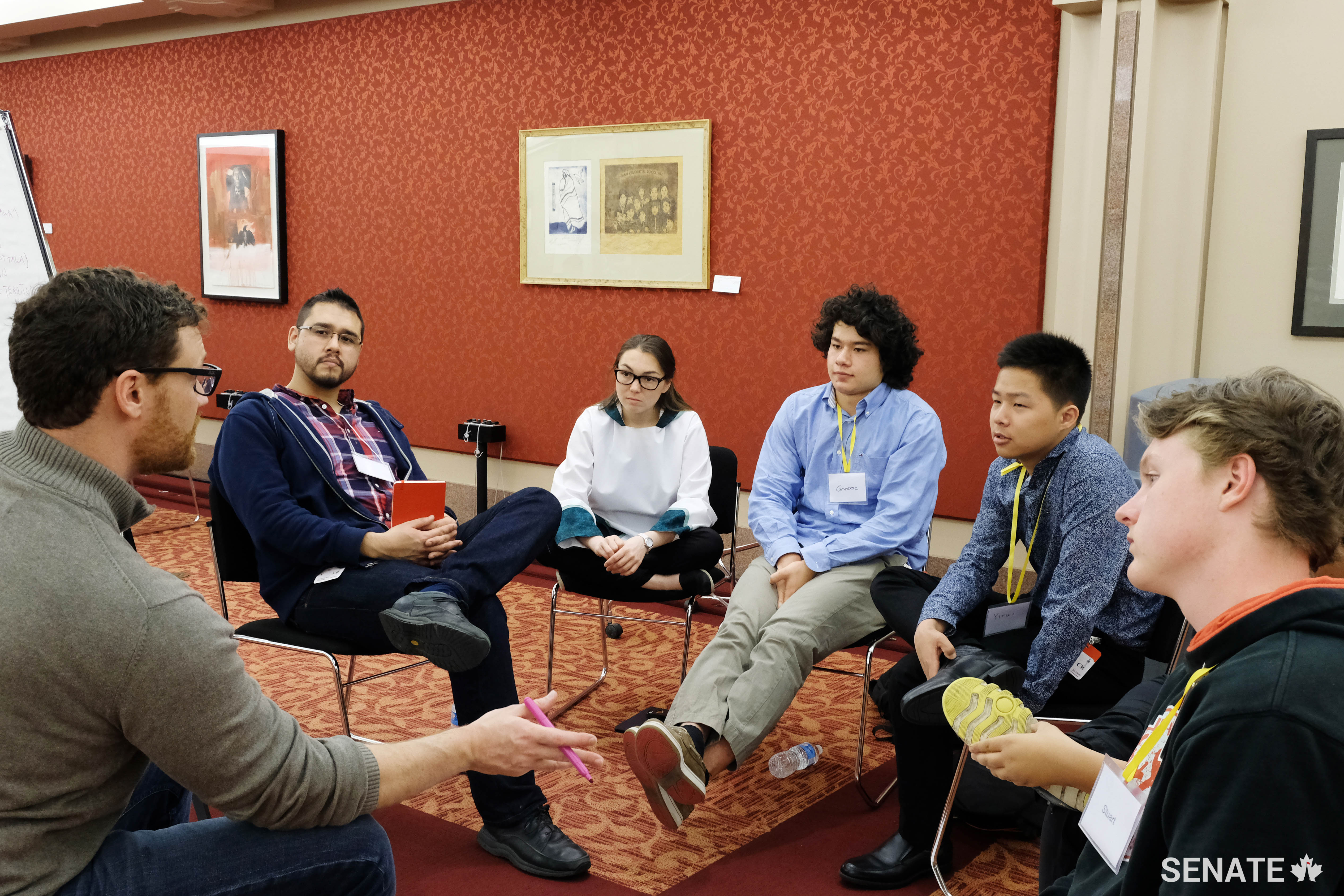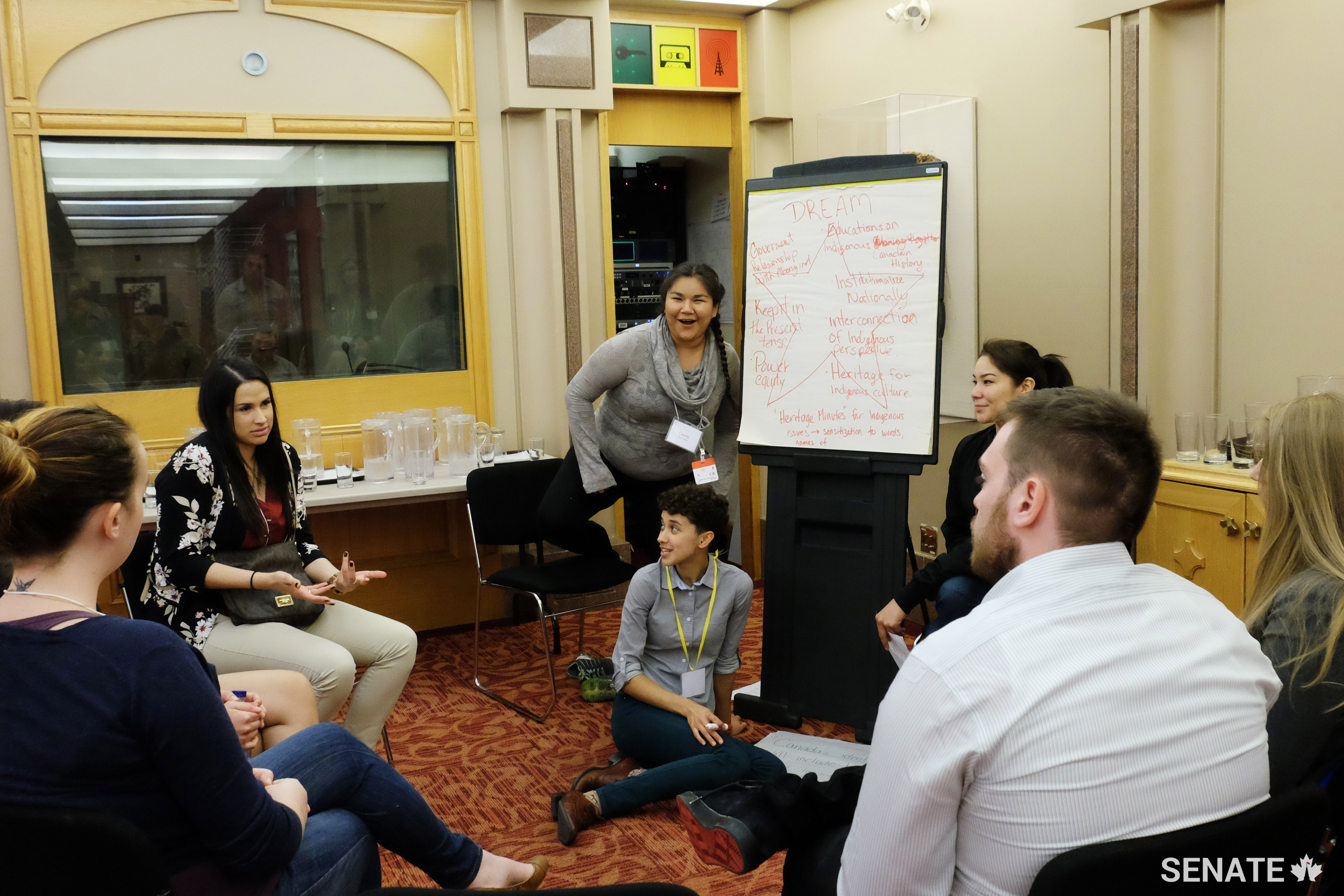Reconciliation starts with dialogue — youth forum indigenizes the Senate: Emily Gjos

Tags
 Emily Gjos
Emily Gjos
Special to SenCAPlus

As we mark the 150th anniversary of Confederation, Canadians are celebrating the history and achievements of this young country. But for many Indigenous people in Canada, there is little to celebrate. It’s in moments of reflection like these that we have the chance to chart a brighter path forward — but it’s going to take dialogue, fresh ideas and a hint of youthful energy.
To some, 150 years might seem like a long time, but Indigenous peoples have been leaving footprints on this land we call Canada for much longer than that. Indigenous peoples grow up learning that their ancestors lived on this land for time immemorial — since the Great Turtle offered his back to the woman that fell through the hole in the sky. As a young person from the Métis community, that was how I was raised.
Non-Indigenous Canadians are not taught this in detail. Nor were they taught the rest of our shared history in my grade-school and secondary-school classrooms. As a result, I was not formally taught about the residential schools, the “Sixties Scoop,” or how these traumas will affect our people for seven generations until I was in my second year of university.
Parliament, and the chambers that dwell within it, are places that have embodied colonial rule over Indigenous peoples — a rule which designed, created and carried out many of the roots of these traumas. But these structures don’t have to be symbolic of the suffering of Indigenous peoples anymore.
On June 7, the Senate of Canada hosted a two-part event (called Youth Indigenize the Senate) proving this exactly — that charting a new relationship between Canada and its First Nations, Inuit and Métis peoples starts with retaking the political space. I was fortunate enough to have participated in one part of this event, which was a forum co-hosted by local, not-for-profit Youth Ottawa where more than 50 Indigenous and non-Indigenous youths from the Ottawa area had the chance to engage collectively in reconciliation-themed workshops.
By inviting Indigenous youth into Parliament, the Senate showed how eager it is to open the doors to our youth to participate in the public life of this country. For one day, we filled the Senate foyer with Indigenous ceremonies and the Senate seats with Indigenous youth. By “indigenizing” the Senate on June 7, I hope we showed what Parliament in a reconciled Canada might look like. It was a powerful sight to behold.
But one day isn’t enough. We’re ready to make use of what we learned that day and to start building that future.
Youth forum participants have put together a report in the Senate style, outlining our findings and compiling our recommendations, to paint the clearest of pictures of how youth see the path forward. We presented this report to the Senate Committee on Aboriginal Peoples on June 20, 2017.
The recommendations include concrete steps that the Senate can take, including advocating for a curriculum for school boards that will help future generations understand how the lived realities of Indigenous peoples in Canada have come to pass.
We also looked at ways to meaningfully engage First Nations, Métis and Inuit in government, business, education and media.
We are committed to seeing this change through by bringing with us the determination and energy that can only come from youth.
Canada 150 cannot just be about celebrating the past — it must have at its core honest introspection. Only then can Canadians find in themselves the will to do better going forward.
The stepping stones are in place: the Truth and Reconciliation Commission’s Calls to Action, the memorandums of understanding between the federal government and Indigenous governments, Canada’s commitment to the United Nations Declarations on the Rights of Indigenous Peoples and Prime Minister Justin Trudeau’s mandate letters to ministers reaffirming that nation-to-nation relationships between Canada and Indigenous peoples are of paramount importance.
Together, we can make the next 150 years a source of pride for all Canadians.
Emily Gjos was a participant at the Youth Indigenize the Senate forum. She is the secretary and treasurer of the Ottawa Region Métis Council.




 Emily Gjos
Emily Gjos
Special to SenCAPlus

As we mark the 150th anniversary of Confederation, Canadians are celebrating the history and achievements of this young country. But for many Indigenous people in Canada, there is little to celebrate. It’s in moments of reflection like these that we have the chance to chart a brighter path forward — but it’s going to take dialogue, fresh ideas and a hint of youthful energy.
To some, 150 years might seem like a long time, but Indigenous peoples have been leaving footprints on this land we call Canada for much longer than that. Indigenous peoples grow up learning that their ancestors lived on this land for time immemorial — since the Great Turtle offered his back to the woman that fell through the hole in the sky. As a young person from the Métis community, that was how I was raised.
Non-Indigenous Canadians are not taught this in detail. Nor were they taught the rest of our shared history in my grade-school and secondary-school classrooms. As a result, I was not formally taught about the residential schools, the “Sixties Scoop,” or how these traumas will affect our people for seven generations until I was in my second year of university.
Parliament, and the chambers that dwell within it, are places that have embodied colonial rule over Indigenous peoples — a rule which designed, created and carried out many of the roots of these traumas. But these structures don’t have to be symbolic of the suffering of Indigenous peoples anymore.
On June 7, the Senate of Canada hosted a two-part event (called Youth Indigenize the Senate) proving this exactly — that charting a new relationship between Canada and its First Nations, Inuit and Métis peoples starts with retaking the political space. I was fortunate enough to have participated in one part of this event, which was a forum co-hosted by local, not-for-profit Youth Ottawa where more than 50 Indigenous and non-Indigenous youths from the Ottawa area had the chance to engage collectively in reconciliation-themed workshops.
By inviting Indigenous youth into Parliament, the Senate showed how eager it is to open the doors to our youth to participate in the public life of this country. For one day, we filled the Senate foyer with Indigenous ceremonies and the Senate seats with Indigenous youth. By “indigenizing” the Senate on June 7, I hope we showed what Parliament in a reconciled Canada might look like. It was a powerful sight to behold.
But one day isn’t enough. We’re ready to make use of what we learned that day and to start building that future.
Youth forum participants have put together a report in the Senate style, outlining our findings and compiling our recommendations, to paint the clearest of pictures of how youth see the path forward. We presented this report to the Senate Committee on Aboriginal Peoples on June 20, 2017.
The recommendations include concrete steps that the Senate can take, including advocating for a curriculum for school boards that will help future generations understand how the lived realities of Indigenous peoples in Canada have come to pass.
We also looked at ways to meaningfully engage First Nations, Métis and Inuit in government, business, education and media.
We are committed to seeing this change through by bringing with us the determination and energy that can only come from youth.
Canada 150 cannot just be about celebrating the past — it must have at its core honest introspection. Only then can Canadians find in themselves the will to do better going forward.
The stepping stones are in place: the Truth and Reconciliation Commission’s Calls to Action, the memorandums of understanding between the federal government and Indigenous governments, Canada’s commitment to the United Nations Declarations on the Rights of Indigenous Peoples and Prime Minister Justin Trudeau’s mandate letters to ministers reaffirming that nation-to-nation relationships between Canada and Indigenous peoples are of paramount importance.
Together, we can make the next 150 years a source of pride for all Canadians.
Emily Gjos was a participant at the Youth Indigenize the Senate forum. She is the secretary and treasurer of the Ottawa Region Métis Council.






